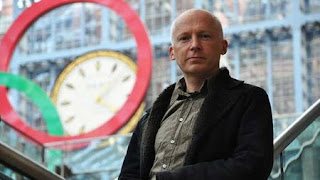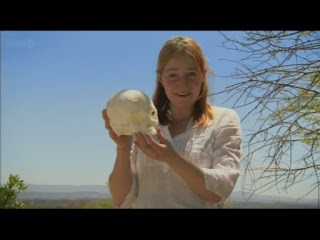THE STORY OF SCIENCEDocumentary, 2010BBChttp://www.imdb.com/title/tt1647292/http://topdocumentaryfilms.com/story-of-science/http://www.bbc.co.uk/programmes/b00s9mmshttp://en.wikipedia.org/wiki/The_Story_of_Science:_Power,_Proof_and_PassionEXCERPTS:EP. 1 -
THE STORY OF SCIENCE
S01E01
WHAT IS OUR THERE[summurise: Geocentric to Heliocentric, Tycho to Newton]This is the story of how history made science and science made history,
and how the ideas that were generated changed our world.
... you and I are actually on a giant rock
which is spinning through empty space at at least 1000 miles ah hour.
Astrology was all about predicting where and how the planets would move.
It was unbelievably tedious work,
hundreds and hundreds of pages of calculations (of Copernicus),
which took him more than fiver years.
As he (Kepler) later wrote,
"If thou, dear reader, are bored with these wearisome calculations,
take pity on me, who did it 70 times."
All planets travel in ellipses around teh Sun.

(Galileo)
He put his findings together into this book,
The Starry Messenger.
Unusually for an astronomical book of its time, it is well written,
it has loverly pictures and very little maths.
In fact, it soon became a 17th cetury bestseller.
...
And then, in 1632,
it all went terribly wrong for Galileo.
He published a book that destroyed his life.
The book enraged the Pope
and remained on the index of prohibited books for more than 200 years.
It's called the Dialogue.
... But worst of all,
that the was really saying is there are truths which
go beyond the realms of religion,
or as he once put it,
"The Bible teaches us how to go to heave,
not how the heavens go."
GLOBAL TRADE
Coffey Shops
They became knows as penny universities.
Newton
His monumental work, explaining that gravity held the universe together,
was published in 1687.
This is
PRINCIPIA by Newton, and it is beautiful.
built on Tycho's observations,
Kepler's elliptical orbits,
and Galileo's discoveries.
Now Newton outlined universal laws of motion
that explained how the planets moved.
Hubble
Universe is expanding.
It seems now we are actually living through a giant cosmic explosion.
Hubble Space Telescope
Four hundred years since Galileo groun his first lenses,
this is what we use to look at what's out there.
... above all, by the marraige of two skills,
the making of instruments and the generating of ideas.
________________________________________
EP. 2
THE STORY OF SCIENE
S01E02
WHAT IS THE WORLD MADE OF[summurise: Chemistry, Air (oxygen, hydrogen, potassium), Atom (electron)]Appearances deceive.
Well, we consist almost entirely of empty space.
If you took the entire population of the world,
all six billion of us,
and removed that empty space,
then we could be squeezed into a cube smaller than that.
(a small sugar cube)
Brand (alchemist)
His discovery was named Giver of Light,
or phosphorus.
It became rather important.
It was later used to make the match.
Joseph Priestley
"He was looking for God,
not just in the Bible but in the natural world."
Lavoisier set off to repeat the (Joseph Priestely's) experiment.
And was soon boasting of his discovery,
the same air (Josp's Pure Air), but with a new name.
Lavoisier called it oxygen.
But what Lavoisier did next
is, I think, a defining moment in the story of science.
He decided to run the Priestley experiment in reverse.
The gas and the shiny metal recombined to form red calx.
Now, the really significant bit,
he foiund it weighed exactly the same as before.
This was to become a fundamental principle of modern chemistry.
Inflammable Air (Hydrogen)
found by Lavoisier in 18th century.
Humphry Dave
discovered Potassium
... And then there was Davy's friend,
the poet, Samuel Taylor Coleridge.
Now, he actually helped coin the name, "scientist,"
to describe what people like Davy did.
Alternatives included, "scientman,"
but it was
"scientist" that stuck.
But the journey that began in the tropics,
with the search for quinine, also led here,
to the killing fields of the Great War.
Uniforms were coloured khaki with artificial dyes.
Explosives wre produced by the same process used to make fertilizers.
It brought us the horrors of poison gas, chlorine,
a gas used in the dye industry that Perkin had pioneered.
Word War I has been described as the chemist war.
Seeing is believing.
Nobody had actually seen an atom.
They're far too small.
Lots of physicists were skeptical about their existence.
J.J. Thomson the Nobel Prize for Physics in 1906.
for discovering the electrons.
The behaviorof electrons could only be described
not as certainties,
but as probabilities.
Now where electrons are,
but where they are likely to be.
The new theory was known as quantum.
Neils Bohr,
the father of quantum physics,
once said that if you're not profoundly shocked
when you hear about it,
then you haven't understood it.
Even Albert Einstein initially rejected quantum theory,
saying, "God does not play dice with the universe."
Now, it is astonishing when you think that in just 60 years,
we have gon from this, a single transistor,
to this, a micro processor that contains over two billion transistors.
___________________________________
EP.3 -
THE STORY OF SCIENCE
S01E03
HOW DID WE GET HERECuvier
All the animals who have hoes and horns
are herbivorous.
In 1844, this slim,
rather ordinary-looking book was first published
and it swiftly became one of the most controversial books
of the Victorian age.
It was a literary sensation selling tens of thousands of copies
and it was read by everyone of influence,
from the Queen downwards.
Adding to its mystique
was the fact that its author mad estrenuous efforts
throughout his lifetime to remain strictly anonymous.
The author was a Scotsman, Robert Chambers.
Chambers called it Vestiges of Natural History of Creation
and it it he presented a compelling case
for the notion that species are not fixed,
they change.
That everything had developed from an earlier form.
He called this concept "transmutation".
We call it "evolution".
... Chambers was not the first person to write about evolution,
but he did take the argument further than others had.
Just as new technology might give one factory an edge over another,
so it was in nature.
They found that the sea floor didn't consist of one thick uniform crust,
as used to be thought,
but a number of think, interlocking plates.
Wegener's Pangea
a never-ending cycle of change that Wegener had called "continental drift".
Because, every time our planet experiences violent change,
a new opportunity for life opens up.
The 18th century
was the age of the experiment.
_______________________________________
EP. 4 -
THE STORY OF SCIENCE
S01E04
CAN WE HAVE UNLIMITED POWER[Machines, Factories, Energy]
Simon Stevin's Windmills
Now the power of windmills helped turn it into an industrial powerhouse.
Holland became av even more dynamic trading nation,
and Amsterdam one of the richest and most cosmopolitan cities on Earth.
Here you could buy almost anything diamonds, furs, exotic spices.
Amsterdam was enjoying a golden age.
The city produced the first central bank,
the first stock exchange and the first economic crash.
BOULTON AND WATT'S STEAM ENGINES
(seed to captalism)
Now the plan was clear.
Boulton had the capital, Watt had the idea.
Together they would get seriously rich.
This was capitalism in action.
The steam engine had enormous global impact.
And yet the surprising thing is,
there was hardly any scientific theory behind it.
That would come later.
... once his engines had been installed,
the money began to flood in.
This three-page document was the key to Boulton and Watt's wealth.
It's a patent.
It covers Watt's adaptations to the steam engine.
Now you had to go on paying royalties year after year,
long after the machine was installed.
Any savings you made from the machine a proportion went straight back to them.
In the early 1800s,
if you wanted to get from A to B
you were better off buying a horse.
The first law of thermodynamics
is a mathematical description of energy
known as conservation of energy.
It states that energy cannot be created or destroyed.
So you can never get more out than is contained in the fuel you put in.
Walsh was convinced that the electricity from the torpedo fish
was not only the same as the electricity in lighning,
but that it must be possible to produce it using machine.
Italian scientist Alessandro Volta.
What's interesting is that Volta,
when he writes to the Royal Society,
he effectively gives away all his secrests,
which is a bit of a shame for him because this turned out
to be one of the greates technological discovereis of all time.
It is, of course, the battery.
What is really surprising,
looking at it from a modern perspective,
is that, for a long time, people had no idea what to do with the batter.
It had no obvious practical application.
There was nothing to plug it into.
It would be generation before somebody manage to find a really significant practical use.
18th June 1815
electric telegraph
Radium is Radioactive

While one ton of radium
could do the work
one hand half million tons of coal.
The theory encapsulated in E=mc2
would eventually lead to the release of nuclear energy and atomic bomb.
Small wonder that our planet alone
in the solar system glows in the dark.
_____________________________________
EP. 5-
THE STORY OF SCIENCE
S01E05
WHAT IS THE SECRET OF LIFE[Human Biology]
Now, I've got a pig's heart here,
which is about the same volume as a human heart.
just over 2 ounces (blood filled in heart)
Harvey did some quick calculations based on how often the heart bearts.
and came up with a figure of 500 ounces.
That's how much blood is passing through the heart every half and hour.
In the 1850s, the first synthetic dyes
burst onto the scene,
creating a whole new range of colours.
Fashoin drove demand.
Painting and the arts were also revitalized.
But it's also shown that the secret of life
deos not lie in simplicity,
in any one chemical or process.
The essence of life lies in complexity.
The hope of finding easy answers has slipped away.

______________________________________
EP. 6 -
THE STORY OF SCIENCE
S01E06
WHO ARE WE [Human Psychology - Chorcot, Freud, Darwin, Cajal, Skinner]
In fact, the idea of being light-hearted or heavy-hearted
com from the Gyptians.
And, in a way, you can understand
why they thought that the emotions resided in the heart.
But, certianly, when I have been broken-hearted,
I've felt it in my gut and in my chest.
Often, the best way to understand the normal
is to study abnormal.
[Cajal discovered brain's neurons by his passion of art and photography.]
because, in Skinner's view,
free will was nothing but an illusion.
famous visual illusion.
Its called the Ames Room.
______________________________________
______________________________________

































